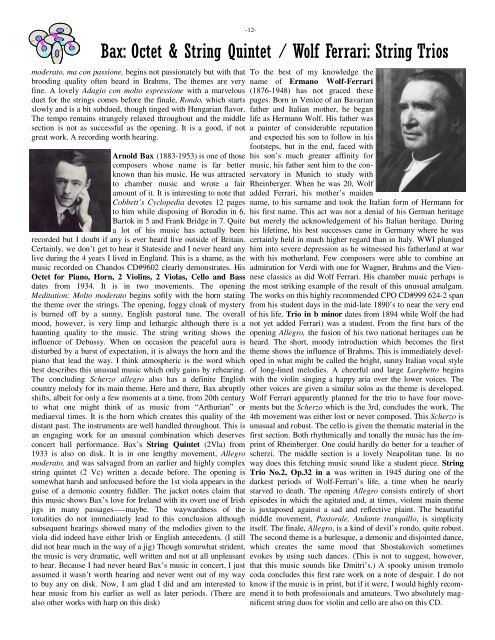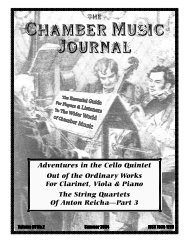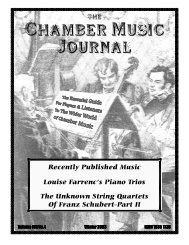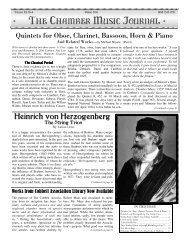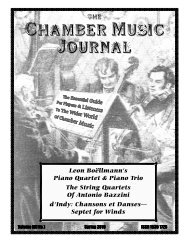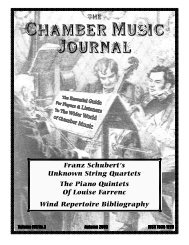Volume 13 No.1
Volume 13 No.1
Volume 13 No.1
Create successful ePaper yourself
Turn your PDF publications into a flip-book with our unique Google optimized e-Paper software.
-12-<br />
Bax: Octet & String Quintet / Wolf Ferrari: String Trios<br />
moderato, ma con passione, begins not passionately but with that<br />
brooding quality often heard in Brahms. The themes are very<br />
fine. A lovely Adagio con molto espressione with a marvelous<br />
duet for the strings comes before the finale, Rondo, which starts<br />
slowly and is a bit subdued, though tinged with Hungarian flavor.<br />
The tempo remains strangely relaxed throughout and the middle<br />
section is not as successful as the opening. It is a good, if not<br />
great work. A recording worth hearing.<br />
Arnold Bax (1883-1953) is one of those<br />
composers whose name is far better<br />
known than his music. He was attracted<br />
to chamber music and wrote a fair<br />
amount of it. It is interesting to note that<br />
Cobbett’s Cyclopedia devotes 12 pages<br />
to him while disposing of Borodin in 6,<br />
Bartok in 5 and Frank Bridge in 7. Quite<br />
a lot of his music has actually been<br />
recorded but I doubt if any is ever heard live outside of Britain.<br />
Certainly, we don’t get to hear it Stateside and I never heard any<br />
live during the 4 years I lived in England. This is a shame, as the<br />
music recorded on Chandos CD#9602 clearly demonstrates. His<br />
Octet for Piano, Horn, 2 Violins, 2 Violas, Cello and Bass<br />
dates from 1934. It is in two movements. The opening<br />
Meditation: Molto moderato begins softly with the horn stating<br />
the theme over the strings. The opening, foggy cloak of mystery<br />
is burned off by a sunny, English pastoral tune. The overall<br />
mood, however, is very limp and lethargic although there is a<br />
haunting quality to the music. The string writing shows the<br />
influence of Debussy. When on occasion the peaceful aura is<br />
disturbed by a burst of expectation, it is always the horn and the<br />
piano that lead the way. I think atmospheric is the word which<br />
best describes this unusual music which only gains by rehearing.<br />
The concluding Scherzo allegro also has a definite English<br />
country melody for its main theme. Here and there, Bax abruptly<br />
shifts, albeit for only a few moments at a time, from 20th century<br />
to what one might think of as music from “Arthurian” or<br />
mediaeval times. It is the horn which creates this quality of the<br />
distant past. The instruments are well handled throughout. This is<br />
an engaging work for an unusual combination which deserves<br />
concert hall performance. Bax’s String Quintet (2Vla) from<br />
1933 is also on disk. It is in one lengthy movement, Allegro<br />
moderato, and was salvaged from an earlier and highly complex<br />
string quintet (2 Vc) written a decade before. The opening is<br />
somewhat harsh and unfocused before the 1st viola appears in the<br />
guise of a demonic country fiddler. The jacket notes claim that<br />
this music shows Bax’s love for Ireland with its overt use of Irish<br />
jigs in many passages—–maybe. The waywardness of the<br />
tonalities do not immediately lead to this conclusion although<br />
subsequent hearings showed many of the melodies given to the<br />
viola did indeed have either Irish or English antecedents. (I still<br />
did not hear much in the way of a jig) Though somewhat strident,<br />
the music is very dramatic, well written and not at all unpleasant<br />
to hear. Because I had never heard Bax’s music in concert, I just<br />
assumed it wasn’t worth hearing and never went out of my way<br />
to buy any on disk. Now, I am glad I did and am interested to<br />
hear music from his earlier as well as later periods. (There are<br />
also other works with harp on this disk)<br />
To the best of my knowledge the<br />
name of Ermano Wolf-Ferrari<br />
(1876-1948) has not graced these<br />
pages. Born in Venice of an Bavarian<br />
father and Italian mother, he began<br />
life as Hermann Wolf. His father was<br />
a painter of considerable reputation<br />
and expected his son to follow in his<br />
footsteps, but in the end, faced with<br />
his son’s much greater affinity for<br />
music, his father sent him to the conservatory<br />
in Munich to study with<br />
Rheinberger. When he was 20, Wolf<br />
added Ferrari, his mother’s maiden<br />
name, to his surname and took the Italian form of Hermann for<br />
his first name. This act was not a denial of his German heritage<br />
but merely the acknowledgement of his Italian heritage. During<br />
his lifetime, his best successes came in Germany where he was<br />
certainly held in much higher regard than in Italy. WWI plunged<br />
him into severe depression as he witnessed his fatherland at war<br />
with his motherland. Few composers were able to combine an<br />
admiration for Verdi with one for Wagner, Brahms and the Viennese<br />
classics as did Wolf Ferrari. His chamber music perhaps is<br />
the most striking example of the result of this unusual amalgam.<br />
The works on this highly recommended CPO CD#999 624-2 span<br />
from his student days in the mid-late 1890’s to near the very end<br />
of his life. Trio in b minor dates from 1894 while Wolf (he had<br />
not yet added Ferrari) was a student. From the first bars of the<br />
opening Allegro, the fusion of his two national heritages can be<br />
heard. The short, moody introduction which becomes the first<br />
theme shows the influence of Brahms. This is immediately developed<br />
in what might be called the bright, sunny Italian vocal style<br />
of long-lined melodies. A cheerful and large Larghetto begins<br />
with the violin singing a happy aria over the lower voices. The<br />
other voices are given a similar solos as the theme is developed.<br />
Wolf Ferrari apparently planned for the trio to have four movements<br />
but the Scherzo which is the 3rd, concludes the work. The<br />
4th movement was either lost or never composed. This Scherzo is<br />
unusual and robust. The cello is given the thematic material in the<br />
first section. Both rhythmically and tonally the music has the imprint<br />
of Rheinberger. One could hardly do better for a teacher of<br />
scherzi. The middle section is a lovely Neapolitan tune. In no<br />
way does this fetching music sound like a student piece. String<br />
Trio No.2, Op.32 in a was written in 1945 during one of the<br />
darkest periods of Wolf-Ferrari’s life, a time when he nearly<br />
starved to death. The opening Allegro consists entirely of short<br />
episodes in which the agitated and, at times, violent main theme<br />
is juxtaposed against a sad and reflective plaint. The beautiful<br />
middle movement, Pastorale, Andante tranquillo, is simplicity<br />
itself. The finale, Allegro, is a kind of devil’s rondo, quite robust.<br />
The second theme is a burlesque, a demonic and disjointed dance,<br />
which creates the same mood that Shostakovich sometimes<br />
evokes by using such dances. (This is not to suggest, however,<br />
that this music sounds like Dmitri’s.) A spooky unison tremolo<br />
coda concludes this first rate work on a note of despair. I do not<br />
know if the music is in print, but if it were, I would highly recommend<br />
it to both professionals and amateurs. Two absolutely magnificent<br />
string duos for violin and cello are also on this CD.


